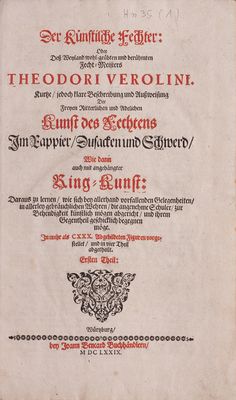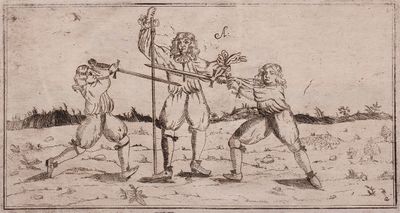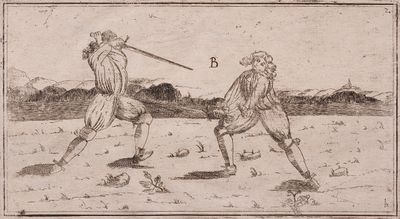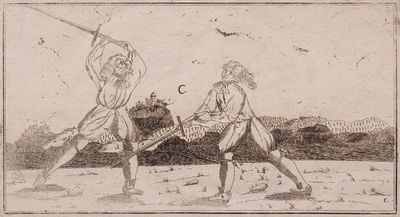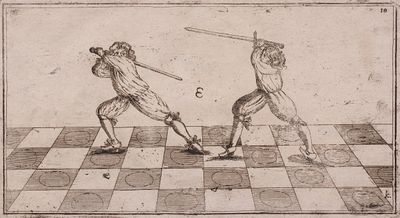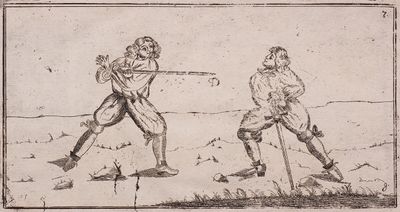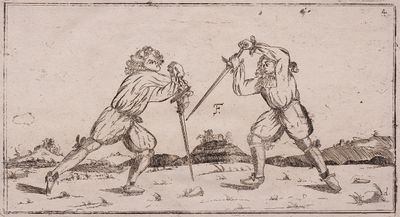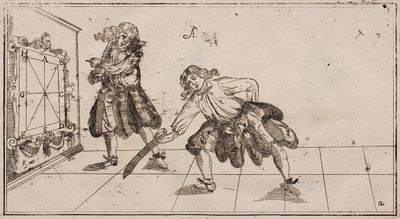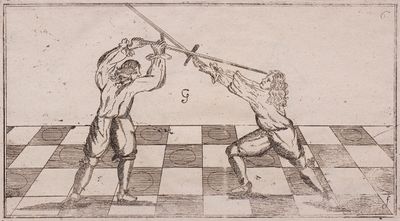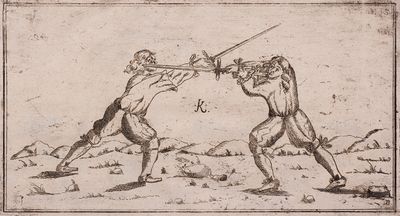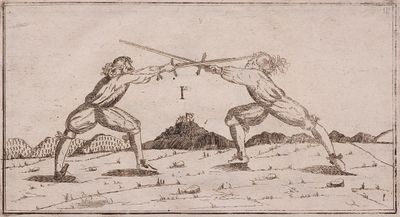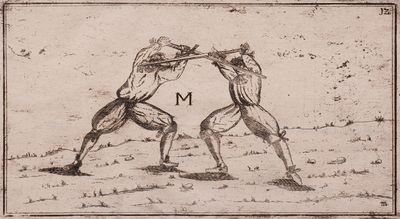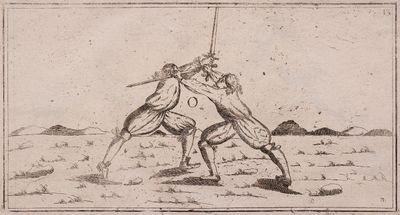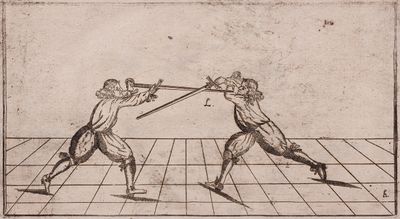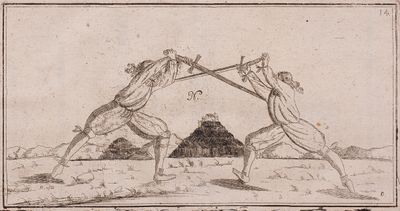|
|
You are not currently logged in. Are you accessing the unsecure (http) portal? Click here to switch to the secure portal. |
Difference between revisions of "Theodori Verolini"
| (7 intermediate revisions by the same user not shown) | |||
| Line 45: | Line 45: | ||
== Treatise == | == Treatise == | ||
| + | |||
| + | The fourth book, on grappling, is laid out on the [[Nicolaes Petter]] page. | ||
{{master begin | {{master begin | ||
| Line 54: | Line 56: | ||
! <p>Illustrations<br/></p> | ! <p>Illustrations<br/></p> | ||
! <p>{{rating|b}}<br/>by [[Reinier van Noort]]</p> | ! <p>{{rating|b}}<br/>by [[Reinier van Noort]]</p> | ||
| − | ! <p>Transcription<br/>by [[András Berki]]</p> | + | ! <p>Transcription{{edit index|Der Kůnstliche Fechter vol. 1 (Theodori Verolini) 1679.pdf}}<br/>by [[András Berki]]</p> |
|- | |- | ||
| − | | | + | | [[File:Verolini 1679 Title 1.jpg|400x400px|center]] |
| | | | ||
{{red|b=1|The Artful Fencer}} | {{red|b=1|The Artful Fencer}} | ||
| Line 91: | Line 93: | ||
<p>I name the beginning the onset, when you set upon the man that you have in front of you. The middle, the working-amongst, or handiwork, when you remain in the bind or longer in your work against the opponent, and harass him with all swiftness. The end, the withdrawal, how a fighter can cut off and away from his opponent without harm.</p> | <p>I name the beginning the onset, when you set upon the man that you have in front of you. The middle, the working-amongst, or handiwork, when you remain in the bind or longer in your work against the opponent, and harass him with all swiftness. The end, the withdrawal, how a fighter can cut off and away from his opponent without harm.</p> | ||
| − | | {{section|Page:Der Kůnstliche Fechter vol. 1 (Theodori Verolini) 1679.pdf/11|1|lbl=1}} | + | | {{section|Page:Der Kůnstliche Fechter vol. 1 (Theodori Verolini) 1679.pdf/11|1|lbl=1.1}} |
|- | |- | ||
| | | | ||
| <p>The onset in the beginning happens out of or from the guards with the cuts, which are twofold, namely the main guards and the secondary guards, that arise from the main guards.</p> | | <p>The onset in the beginning happens out of or from the guards with the cuts, which are twofold, namely the main guards and the secondary guards, that arise from the main guards.</p> | ||
| − | | {{section|Page:Der Kůnstliche Fechter vol. 1 (Theodori Verolini) 1679.pdf/11|2|lbl= | + | | {{section|Page:Der Kůnstliche Fechter vol. 1 (Theodori Verolini) 1679.pdf/11|2|lbl=1.2}} |
|- | |- | ||
| | | | ||
| − | | <p>There are four main guards, the Tag or Upper-ward, the Ochs, the Olber, and the Pflug. There are eight secondary guards: Wrath-ward, Break-window, Long-point, Barrier-ward, Unicorn, Key, Iron-gate, Change. But as far as the sword is concerned the cuts are in two sorts, which two are generally named the straight and reverse cuts. The first are called the main or principal cuts, from which all other cuts have their origin, and of these there are four: Upper-, Under-, Middle- and Wrath-cut. The others are called the secondary, or derived cuts, and there are twelve of them, namely Squint-, Crooked-, Shorten-, Glinting-, Bruising-; single and double, Blinding-, Winding-, Crown-, Knuckle-, Plunge-, and Change-cut. From these two are taken the true Master-cuts, which are named so because all masterly and artful devices with the sword are grasped and completed in these, namely Wrath-, Crooked-, Athwart-, Squint-, and Crest-cut. And of all these I will clearly bring to the light how to complete and perform them in their description, when I come to the onset, and speak of the cuts.</p> | + | | <p>There are four main guards, the ''Tag'' or Upper-ward, the ''Ochs'', the ''Olber'', and the ''Pflug''. There are eight secondary guards: Wrath-ward, Break-window, Long-point, Barrier-ward, Unicorn, Key, Iron-gate, Change. But as far as the sword is concerned the cuts are in two sorts, which two are generally named the straight and reverse cuts. The first are called the main or principal cuts, from which all other cuts have their origin, and of these there are four: Upper-, Under-, Middle- and Wrath-cut. The others are called the secondary, or derived cuts, and there are twelve of them, namely Squint-, Crooked-, Shorten-, Glinting-, Bruising-; single and double, Blinding-, Winding-, Crown-, Knuckle-, Plunge-, and Change-cut. From these two are taken the true Master-cuts, which are named so because all masterly and artful devices with the sword are grasped and completed in these, namely Wrath-, Crooked-, Athwart-, Squint-, and Crest-cut. And of all these I will clearly bring to the light how to complete and perform them in their description, when I come to the onset, and speak of the cuts.</p> |
| − | | {{section|Page:Der Kůnstliche Fechter vol. 1 (Theodori Verolini) 1679.pdf/11|3|lbl= | + | | {{section|Page:Der Kůnstliche Fechter vol. 1 (Theodori Verolini) 1679.pdf/11|3|lbl=1.3}} |
|- | |- | ||
| | | | ||
| <p>The handiwork in the middle contains the greatest art, and all swiftness that can occur in fencing. Since this does not only indicate, how you shall bind the sword, wind, change, deceive, travel after, slice, double, let it run off, or in which manner you shall strike around, sling, slide in front, set aside, pull and jerk, block, grapple, run in, throw and press after</p> | | <p>The handiwork in the middle contains the greatest art, and all swiftness that can occur in fencing. Since this does not only indicate, how you shall bind the sword, wind, change, deceive, travel after, slice, double, let it run off, or in which manner you shall strike around, sling, slide in front, set aside, pull and jerk, block, grapple, run in, throw and press after</p> | ||
| − | | {{section|Page:Der Kůnstliche Fechter vol. 1 (Theodori Verolini) 1679.pdf/11|4|lbl= | + | | {{section|Page:Der Kůnstliche Fechter vol. 1 (Theodori Verolini) 1679.pdf/11|4|lbl=1.4}} |
|- | |- | ||
| − | | | + | | [[File:Verolini 1679 Sword A.jpg|400x400px|center]] |
| <p>'''Of the man and his division.'''</p> | | <p>'''Of the man and his division.'''</p> | ||
<p>The man is divided into four parts, namely the above and under, and each of these in right and left. How the appearance of someone indicates what parts of him are above and below, and left and right, is explained by the image in Figure A.</p> | <p>The man is divided into four parts, namely the above and under, and each of these in right and left. How the appearance of someone indicates what parts of him are above and below, and left and right, is explained by the image in Figure A.</p> | ||
| − | | {{section|Page:Der Kůnstliche Fechter vol. 1 (Theodori Verolini) 1679.pdf/11|5|lbl= | + | | {{section|Page:Der Kůnstliche Fechter vol. 1 (Theodori Verolini) 1679.pdf/11|5|lbl=1.5}} |
|- | |- | ||
| Line 120: | Line 122: | ||
<p>The blade has two divisions. The first is into the strong and weak. The second into the short and long edge, i.e. front and back.</p> | <p>The blade has two divisions. The first is into the strong and weak. The second into the short and long edge, i.e. front and back.</p> | ||
| − | | {{section|Page:Der Kůnstliche Fechter vol. 1 (Theodori Verolini) 1679.pdf/11|6|lbl= | + | | {{section|Page:Der Kůnstliche Fechter vol. 1 (Theodori Verolini) 1679.pdf/11|6|lbl=1.6}} |
|- | |- | ||
| | | | ||
| <p>The part from the cross or hilt to the middle of the blade is named the strong of the sword. The weak is from the middle to the end of the same.</p> | | <p>The part from the cross or hilt to the middle of the blade is named the strong of the sword. The weak is from the middle to the end of the same.</p> | ||
| − | | {{section|Page:Der Kůnstliche Fechter vol. 1 (Theodori Verolini) 1679.pdf/11|7|lbl=-}} | + | | {{section|Page:Der Kůnstliche Fechter vol. 1 (Theodori Verolini) 1679.pdf/11|7|lbl=1.7}} |
| + | |||
| + | |- | ||
| + | | rowspan="5" | [[File:Verolini 1679 Sword A.jpg|400x400px|center]] | ||
| + | | <p>In general the sword has four parts as can be seen in Figure A.</p> | ||
| + | | {{section|Page:Der Kůnstliche Fechter vol. 1 (Theodori Verolini) 1679.pdf/11|8|lbl=1.8}} | ||
| + | |||
| + | |- | ||
| + | | <p>The first is named the hilt, and contains the pommel and cross. Expedient for grappling, gripping, and throwing.</p> | ||
| + | | {{section|Page:Der Kůnstliche Fechter vol. 1 (Theodori Verolini) 1679.pdf/11|9|lbl=1.9}} | ||
| + | |||
| + | |- | ||
| + | | <p>The second, the strong, is useful for slicing, winding, pushing and what is fenced from the strong.</p> | ||
| + | | {{section|Page:Der Kůnstliche Fechter vol. 1 (Theodori Verolini) 1679.pdf/12|1|lbl=2.1}} | ||
| + | |||
| + | |- | ||
| + | | <p>The third part is the middle, which is used on every occasion.</p> | ||
| + | | {{section|Page:Der Kůnstliche Fechter vol. 1 (Theodori Verolini) 1679.pdf/12|2|lbl=2.2}} | ||
| + | |||
| + | |- | ||
| + | | <p>The fourth is the weak, for changing through, flicking, slinging, for which you will have examples, then.</p> | ||
| + | | {{section|Page:Der Kůnstliche Fechter vol. 1 (Theodori Verolini) 1679.pdf/12|3|lbl=2.3}} | ||
| + | |||
| + | |- | ||
| + | | | ||
| + | | <p>'''Of the guards or wards.'''</p> | ||
| + | |||
| + | <p>The wards and guards are graceful, in which the fencer positions and sets himself in the place before his opponent comes to him, so that he is not rushed unforeseen, and injured by him, setting himself against the counterpart. As a man is divided into four quarters, high, low, left, and right, there are likewise four openings in which to hit the opponent mainly. And as there are four openings, there are likewise four main guards or wards, from which all the others derive and arise, as there are ''Ochs'', ''Pflug'', ''Tag'' and ''Olber''. But the others, that have originated from these, are Wrath-ward, Long-point, Change, Side-ward, Iron-gate, Hanging-point, Key, Unicorn, which then will be treated orderly and briefly.</p> | ||
| + | | {{section|Page:Der Kůnstliche Fechter vol. 1 (Theodori Verolini) 1679.pdf/12|4|lbl=2.4}} | ||
| + | |||
| + | |- | ||
| + | | [[File:Verolini 1679 Sword B.jpg|400x400px|center]] | ||
| + | | <p>'''''Ochs.'''''</p> | ||
| + | |||
| + | <p>The upper part of a man is assigned to the ''Ochs'', and as that part has two quarters, the right and the left, the guard of ''Ochs'' can also be divided into two, as is demonstrated in Figure B.</p> | ||
| + | | {{section|Page:Der Kůnstliche Fechter vol. 1 (Theodori Verolini) 1679.pdf/12|5|lbl=2.5}} | ||
| + | |||
| + | |- | ||
| + | | [[File:Verolini 1679 Sword B.jpg|400x400px|center]] | ||
| + | | <p>'''''Pflug.'''''</p> | ||
| + | |||
| + | <p>The lower part of a man is dedicated to the ''Pflug'', and like that part has two quarters, the right and the left, hence the ''Pflug'' is also called the right and the left, or the point in the man’s face is also the right ''Pflug'' in the conceived Figure B.</p> | ||
| + | </p> | ||
| + | | {{section|Page:Der Kůnstliche Fechter vol. 1 (Theodori Verolini) 1679.pdf/12|6|lbl=2.6}} | ||
| + | |||
| + | |- | ||
| + | | [[File:Verolini 1679 Sword C.jpg|400x400px|center]] | ||
| + | | <p>'''''Tag.'''''</p> | ||
| + | |||
| + | <p>Stand with your left foot in front, hold your sword high over your head, as in the Figure B.<ref>This is a typo and should be Figure C.</ref></p> | ||
| + | | {{section|Page:Der Kůnstliche Fechter vol. 1 (Theodori Verolini) 1679.pdf/12|7|lbl=2.7}} | ||
| + | |||
| + | |- | ||
| + | | [[File:Verolini 1679 Sword C.jpg|400x400px|center]] | ||
| + | | <p>'''''Olber.'''''</p> | ||
| + | |||
| + | <p>Stand with the left foot in front, hold your sword with the point stretched out in front of you to the ground, in front of your front foot, so that the short edge is above, the long below. Thus you stand well in this ward, as you can see in Figure C.</p> | ||
| + | | {{section|Page:Der Kůnstliche Fechter vol. 1 (Theodori Verolini) 1679.pdf/12|8|lbl=2.8}} | ||
| + | |||
| + | |- | ||
| + | | [[File:Verolini 1679 Sword E.jpg|400x400px|center]] | ||
| + | | <p>'''Wrath-ward.'''</p> | ||
| + | |||
| + | <p>Stand with your left foot in front, hold your sword on the right shoulder, see Figure E.</p> | ||
| + | | {{section|Page:Der Kůnstliche Fechter vol. 1 (Theodori Verolini) 1679.pdf/12|9|lbl=2.9}} | ||
| + | |||
| + | |- | ||
| + | | [[File:Verolini 1679 Sword A.jpg|400x400px|center]] | ||
| + | | <p>'''Long-point.'''</p> | ||
| + | |||
| + | <p>Stand with your left foot in front, hold your weapon with outstretched arms, long in front of your face, as Figure A teaches you.</p> | ||
| + | | {{section|Page:Der Kůnstliche Fechter vol. 1 (Theodori Verolini) 1679.pdf/12|10|lbl=2.10}} | ||
| + | |||
| + | |- | ||
| + | | [[File:Verolini 1679 Sword D.jpg|400x400px|center]] | ||
| + | | <p>'''Change.'''</p> | ||
| + | |||
| + | <p>Stand with your right foot in front, hold your weapon with the weak to the ground next to you stretched out to the side, as in Figure D.</p> | ||
| + | | {{section|Page:Der Kůnstliche Fechter vol. 1 (Theodori Verolini) 1679.pdf/12|11|lbl=2.11}} | ||
|- | |- | ||
| + | | [[File:Verolini 1679 Sword F.jpg|400x400px|center]] | ||
| + | | <p>'''Side-ward.'''</p> | ||
| + | |||
| + | <p>Stand with the left foot in front, hold your sword next to your right, with the point to the ground, as in Figure [F].<ref>This should be Figure F. Note that the fencer standing in Side-ward in this figure grips the ricasso with his right hand.</ref></p> | ||
| + | | {{section|Page:Der Kůnstliche Fechter vol. 1 (Theodori Verolini) 1679.pdf/12|12|lbl=2.12}} | ||
| + | |||
| + | |- | ||
| + | | [[File:Verolini 1679 Sword F.jpg|400x400px|center]] | ||
| + | | <p>'''Iron-gate.'''</p> | ||
| + | |||
| + | <p>Stand with your right foot in front, hold your sword with the hilt in front of your knee, with strong<ref name="three">It is not unlikely that instead of starck (“strong”), strack (“straight”) was meant here.</ref> hanging arms, as can be seen in Figure F.<ref>Iron-gate is not shown here (see also [[Joachim Meyer|Meyer]], 1570).</ref></p> | ||
| + | | {{section|Page:Der Kůnstliche Fechter vol. 1 (Theodori Verolini) 1679.pdf/12|13|lbl=2.13}} | ||
| + | |||
| + | |- | ||
| + | | [[File:Verolini 1679 Sword B.jpg|400x400px|center]] | ||
| + | | <p>'''Hanging-point.'''</p> | ||
| + | |||
| + | <p>This guard is almost completely of the same shape as the ''Ochs'', except that in the ''Ochs'' you hold the arm strongly<ref name="three"/> up high, as in Figure B.</p> | ||
| + | | {{section|Page:Der Kůnstliche Fechter vol. 1 (Theodori Verolini) 1679.pdf/12|14|lbl=2.14}} | ||
| + | |||
| + | |- | ||
| + | | [[File:Verolini 1679 Sword D.jpg|400x400px|center]] | ||
| + | | <p>'''Key.'''</p> | ||
| + | |||
| + | <p>Stand with your left foot in front, and hold your sword with the hilt and crossed hands in front of your breast, as in Figure D.</p> | ||
| + | | {{section|Page:Der Kůnstliche Fechter vol. 1 (Theodori Verolini) 1679.pdf/12|15|lbl=2.15}} | ||
| + | |||
| + | |- | ||
| + | | [[File:Verolini 1679 Sword E.jpg|400x400px|center]] | ||
| + | | <p>'''Unicorn.'''</p> | ||
| + | |||
| + | <p>Come into the onset with the left foot in front. Wing up from both sides, as if you want to set yourself in the aforementioned Key, as in Figure E.</p> | ||
| + | | {{section|Page:Der Kůnstliche Fechter vol. 1 (Theodori Verolini) 1679.pdf/12|16|lbl=2.16}} | ||
| + | |||
| + | |- | ||
| + | | [[File:Verolini 1679 Dussack A.jpg|400x400px|center]] | ||
| + | | <p>'''Of the guards.'''</p> | ||
| + | |||
| + | <p>Firstly, when you do the Upper- or Crest-cut, you will find three guards, as in the beginning you are in ''Tag'', in the middle in Long-point, at the end in ''Olber'', thus from the top down you have three wards or guards from A. and E. When you go up again from below with crossed hands to the displacement, you again find three guards. Namely at the beginning Iron-gate, in the middle the ''Hangort'', at the end upwards at full height the Unicorn. If you pull your sword with the hilt in front of the breast, so that the half edge lies on your left arm, then you stand in Key. Thus you can go up and down in the line A. and E. from one guard into the other.</p> | ||
| | | | ||
| − | | <p>In | + | {{section|Page:Der Kůnstliche Fechter vol. 1 (Theodori Verolini) 1679.pdf/12|17|lbl=2.17|p=1}} {{section|Page:Der Kůnstliche Fechter vol. 1 (Theodori Verolini) 1679.pdf/13|1|lbl=3.1|p=1}} |
| − | | {{section|Page:Der Kůnstliche Fechter vol. 1 (Theodori Verolini) 1679.pdf/11| | + | |
| + | |- | ||
| + | | [[File:Verolini 1679 Dussack A.jpg|400x400px|center]] | ||
| + | | <p>Of the other Lines, which strike diagonally downwards through the right Line, there are two. One that strikes from the right upper quarter, indicated with H. and D., and the other which goes from the left upper part to the right lower part, demonstrated in B.F. You can now cut through which you want. If you then pull the strike up again with the long edge, then you again go through three guards, as at the beginning there is the Side-ward, in the middle again the Long-point, and in the end upwards the Unicorn. If you strike one through the above-mentioned Line, it can be from which side you want, then you come from the Change, through the Long-point, into the Wrath-ward. In striking up, you can also turn your sword in the Hanging-point, from which you come into the ward of ''Ochs'' when you go further upwards. Thus you always find at least three guards whenever you go through one of the demonstrated Lines.</p> | ||
| + | | {{section|Page:Der Kůnstliche Fechter vol. 1 (Theodori Verolini) 1679.pdf/13|2|lbl=3.2}} | ||
| + | |||
| + | |- | ||
| + | | | ||
| + | | <p>But a good fencer will not habituate to wait long in his guard, but as soon as he can reach an opponent, he will attack him, and fence out his intended device.</p> | ||
| + | | {{section|Page:Der Kůnstliche Fechter vol. 1 (Theodori Verolini) 1679.pdf/13|3|lbl=3.3}} | ||
| + | |||
| + | |- | ||
| + | | [[File:Verolini 1679 Dussack A.jpg|400x400px|center]] | ||
| + | | <p>'''Middle- or Across-cut.'''<ref>''Überzwerch'' is somewhat tricky to translate. It literally means “across” and thus indicates a movement or position crossing the centre line between the fighters. However, in some cases it could also be translated as “horizontal”. Here, we have chosen to consistenly translate as “across”.</ref></p> | ||
| + | |||
| + | <p>The Middle- or Across-cut can almost completely be performed as the Wrath-cut, only this is the difference that the Wrath-cut is performed diagonally over the point, but this one across, as recorded in the Figures C. and G.<ref>This is an error, and intended to refer to the G-C line on the cutting diagram.</ref></p> | ||
| + | | {{section|Page:Der Kůnstliche Fechter vol. 1 (Theodori Verolini) 1679.pdf/13|4|lbl=3.4}} | ||
| + | |||
| + | |- | ||
| + | | [[File:Verolini 1679 Sword B.jpg|400x400px|center]] | ||
| + | | <p>'''Undercut.'''</p> | ||
| + | |||
| + | <p>Cut across from below, to his left arm, so that with your cross you come high above your head, as in Figure B.</p> | ||
| + | | {{section|Page:Der Kůnstliche Fechter vol. 1 (Theodori Verolini) 1679.pdf/13|5|lbl=3.5}} | ||
| + | |||
| + | |- | ||
| + | | [[File:Verolini 1679 Sword Ga.jpg|400x400px|center]] | ||
| + | | <p>'''Squint-cut.'''</p> | ||
| + | |||
| + | <p>Set yourself in the ward of the Tag or the Wrath-ward with the left foot in front. If someone cuts at you, then cut against it, but in the strike turn your short edge against his strike, as in Figure G.</p> | ||
| + | | {{section|Page:Der Kůnstliche Fechter vol. 1 (Theodori Verolini) 1679.pdf/13|6|lbl=3.6}} | ||
| + | |||
| + | |- | ||
| + | | [[File:Verolini 1679 Sword D.jpg|400x400px|center]] | ||
| + | | <p>'''Crooked-cut.'''</p> | ||
| + | |||
| + | <p>Stand in the Wrath-ward with the left foot in front. If your opponent cuts at you, then step with your right foot in front, cut with the long edge against his cut, between his head and his blade, as in Figure D.</p> | ||
| + | | {{section|Page:Der Kůnstliche Fechter vol. 1 (Theodori Verolini) 1679.pdf/13|7|lbl=3.7}} | ||
| + | |||
| + | |- | ||
| + | | [[File:Verolini 1679 Sword E.jpg|400x400px|center]] | ||
| + | | <p>'''Athwart-cut.'''</p> | ||
| + | |||
| + | <p>Place yourself in the Wrath-ward on the right side. Set your left foot in front, hold your sword on your right shoulder, as in Figure H.<ref>This is a typo and should be Figure E.</ref></p> | ||
| + | | {{section|Page:Der Kůnstliche Fechter vol. 1 (Theodori Verolini) 1679.pdf/13|8|lbl=3.8}} | ||
| + | |||
| + | |- | ||
| + | | [[File:Verolini 1679 Sword B.jpg|400x400px|center]] | ||
| + | | <p>'''Shorten-cut.'''</p> | ||
| + | |||
| + | <p>Strike with the half edge and crossed arms over his right arm to the head, as in Figure B.</p> | ||
| + | | {{section|Page:Der Kůnstliche Fechter vol. 1 (Theodori Verolini) 1679.pdf/13|9|lbl=3.9}} | ||
| + | |||
| + | |- | ||
| + | | [[File:Verolini 1679 Sword K.jpg|400x400px|center]] | ||
| + | |||
| + | [[File:Verolini 1679 Sword I.jpg|400x400px|center]] | ||
| + | | <p>'''Bruising-cut.'''</p> | ||
| + | |||
| + | <p>When your counterpart cuts at you from above, then meet his strike with an Athwart-cut, as recorded in Figure K and I.</p> | ||
| + | | {{section|Page:Der Kůnstliche Fechter vol. 1 (Theodori Verolini) 1679.pdf/13|10|lbl=3.10}} | ||
| + | |||
| + | |- | ||
| + | | [[File:Verolini 1679 Sword E.jpg|400x400px|center]] | ||
| + | | <p>'''Winding-cut.'''</p> | ||
| + | |||
| + | <p>If your counterpart cuts at you from above, then cut from below with crossed hands, from your left to his sword, as in Figure H.<ref>Maybe also E.</ref></p> | ||
| + | | {{section|Page:Der Kůnstliche Fechter vol. 1 (Theodori Verolini) 1679.pdf/13|11|lbl=3.11}} | ||
| + | |||
| + | |- | ||
| + | | | ||
| + | | <p>'''Crown-cut.'''</p> | ||
| + | |||
| + | <p>When your counterpart cuts at you from above, then go upwards with the cross across, catch him his strike in the air on your shield or crossbar.</p> | ||
| + | | {{section|Page:Der Kůnstliche Fechter vol. 1 (Theodori Verolini) 1679.pdf/13|12|lbl=3.12}} | ||
| + | |||
| + | |- | ||
| + | | | ||
| + | | <p>'''Knuckle-cut, Plunge-cut, Change-cut.'''</p> | ||
| + | |||
| + | <p>The Change-cut is nothing else than always alternating the cuts before the man from one side to the other, from above to below, and back again, to make him err.</p> | ||
| + | | {{section|Page:Der Kůnstliche Fechter vol. 1 (Theodori Verolini) 1679.pdf/13|13|lbl=3.13}} | ||
| + | |||
| + | |- | ||
| + | | | ||
| + | | <p>'''Shooting or Provoke-touching.'''</p> | ||
| + | |||
| + | <p>Shooting or Provoke-touching are almost one thing, which actually are not cuts that are cut but flicked.</p> | ||
| + | | {{section|Page:Der Kůnstliche Fechter vol. 1 (Theodori Verolini) 1679.pdf/13|14|lbl=3.14}} | ||
|- | |- | ||
| | | | ||
| − | | <p>The | + | | <p>'''Handiwork.'''</p> |
| − | | {{section|Page:Der Kůnstliche Fechter vol. 1 (Theodori Verolini) 1679.pdf/ | + | |
| + | <p>The full handiwork consists mainly of binding or staying, traveling after, slicing, striking around, running around, deceiving, flitting, setting aside, displacing, pulling, doubling, reversing, snapping, feinting, looping circles, winding, winding through, changing, Changing through, slicing off, pressing hands, sliding in front, hanging, wrenching out, barring, blocking, gripping over, running in, etc.</p> | ||
| + | |||
| + | | {{section|Page:Der Kůnstliche Fechter vol. 1 (Theodori Verolini) 1679.pdf/14|1|lbl=4.1}} | ||
|- | |- | ||
| | | | ||
| − | | <p> | + | | <p>'''Binding, staying, feeling.'''</p> |
| + | |||
| + | <p>Is when the swords touch one another. Staying is twofold, when the swords held to each other, to see how the man wants to fight etc.</p> | ||
| + | | {{section|Page:Der Kůnstliche Fechter vol. 1 (Theodori Verolini) 1679.pdf/14|2|lbl=4.2}} | ||
| + | |||
| + | |- | ||
| | | | ||
| + | | <p>'''Slicing.'''</p> | ||
| + | |||
| + | <p>After you have received your opponent's sword with the bind, you will remain on there, to feel if he wants to go from the bind, or strike around. Let it fly, and before he can recover, you cut to the nearest opening.</p> | ||
| + | | {{section|Page:Der Kůnstliche Fechter vol. 1 (Theodori Verolini) 1679.pdf/14|3|lbl=4.3}} | ||
|- | |- | ||
| | | | ||
| − | | <p> | + | | <p>'''Striking around.'''</p> |
| + | |||
| + | <p>When you are bound from your right against his left, and you go away again that bind, to strike around or flick to to the other side.</p> | ||
| + | | {{section|Page:Der Kůnstliche Fechter vol. 1 (Theodori Verolini) 1679.pdf/14|4|lbl=4.4}} | ||
| + | |||
| + | |- | ||
| | | | ||
| + | | <p>'''Deceiving.'''</p> | ||
| + | |||
| + | <p>When you show yourself with gestures as if you want to onset an opening on your counterpart, but you do not do it, and strike the strike in to another opening.</p> | ||
| + | | {{section|Page:Der Kůnstliche Fechter vol. 1 (Theodori Verolini) 1679.pdf/14|5|lbl=4.5}} | ||
| + | |||
| + | |- | ||
| + | | [[File:Verolini 1679 Sword A.jpg|400x400px|center]] | ||
| + | | <p>If your counterpart cuts at you from above, then step and from your right side, with a Middle-cut across, cutting his strike away from you with the long edge as it flies in, then through so that your blade flies around again, with the half edge against his left ear, as can be seen in Figure A.</p> | ||
| + | | {{section|Page:Der Kůnstliche Fechter vol. 1 (Theodori Verolini) 1679.pdf/14|6|lbl=4.6}} | ||
| + | |||
| + | |- | ||
| + | | [[File:Verolini 1679 Sword K.jpg|400x400px|center]] | ||
| + | | <p>In the taking-out course, let your blade, in one flight, fly with an Athwart-cut above around your head, against his left ear. Then pull your sword around your head again, and with the outside flat cut a strongly swung in strike on the outside to his right ear, as you see this flat strike painted in the large image on the right hand side in Figure K.</p> | ||
| + | | {{section|Page:Der Kůnstliche Fechter vol. 1 (Theodori Verolini) 1679.pdf/14|7|lbl=4.7}} | ||
| + | |||
| + | |- | ||
| + | | [[File:Verolini 1679 Sword F.jpg|400x400px|center]] | ||
| + | | <p>'''Hanging-point.'''</p> | ||
| + | |||
| + | <p>In the onset strike through powerfully from your left side upwards against his face, in one wheel once, twice, and the third time, however, always let your sword swing in front of your face, or turn into the Hanging-point, as the image on the right hand side in Figure F here presented teaches you.</p> | ||
| + | | {{section|Page:Der Kůnstliche Fechter vol. 1 (Theodori Verolini) 1679.pdf/14|8|lbl=4.8}} | ||
| + | |||
| + | |- | ||
| + | | [[File:Verolini 1679 Sword M.jpg|400x400px|center]] | ||
| + | | <p>'''Break-window.'''</p> | ||
| + | |||
| + | <p>If someone cuts from above, then cut against this from your left from below with the long edge, and when he takes his sword off yours again, and thus drives with his arms upwards, then in the meantime grip with your fingers over your cross on the blade, and drive with your blade over both his arms, as you see this on Figure M.</p> | ||
| + | | {{section|Page:Der Kůnstliche Fechter vol. 1 (Theodori Verolini) 1679.pdf/14|9|lbl=4.9}} | ||
| + | |||
| + | |- | ||
| + | | [[File:Verolini 1679 Sword Ga.jpg|400x400px|center]] | ||
| + | | <p>Step in haste, and cut in from below to his left side, so that your hands stay high. With this you force him to either displace you from his guard, or to cut in at the same time with a step back. If he then cuts, then note the moment the swords beat together, and pull around the head, and cut in to his right ear in one swing with crossed hands, with the short edge, as this Figure G. shows.</p> | ||
| + | | {{section|Page:Der Kůnstliche Fechter vol. 1 (Theodori Verolini) 1679.pdf/14|10|lbl=4.10}} | ||
| + | |||
| + | |- | ||
| + | | [[File:Verolini 1679 Sword O.jpg|400x400px|center]] | ||
| + | | <p>'''A fine device from the reversing.'''</p> | ||
| + | |||
| + | <p>In the onset note and watch out for when your opponent rises before you. Then step and cut from your left side with the short edge and crossed hands to or over the right arm, but in this Crooked-cut step well to him, reverse your sword and wrench out downwards, on your right side. If he works upwards with his arms so that you can force him downwards, then drive with the pommel from inside between both his arms, loosen your left hand from the hilt, and with that grip your sword’s blade, and wrench out upwards, as Figure O. demonstrates.</p> | ||
| + | | {{section|Page:Der Kůnstliche Fechter vol. 1 (Theodori Verolini) 1679.pdf/14|11|lbl=4.11}} | ||
| + | |||
| + | |- | ||
| + | | [[File:Verolini 1679 Sword L.jpg|400x400px|center]] | ||
| + | | <p>'''Counter for the Athwart-cut.'''</p> | ||
| + | |||
| + | <p>When you bind with someone from above, or cut in at the same time with him, then see whether he wants to strike around with the Athwart-cut. While he strikes around, preempt with the Athwart-cut below his blade to his neck, as Figure L. demonstrates.</p> | ||
| + | | {{section|Page:Der Kůnstliche Fechter vol. 1 (Theodori Verolini) 1679.pdf/14|12|lbl=4.12}} | ||
| + | |||
| + | |- | ||
| + | | [[File:Verolini 1679 Sword N.jpg|400x400px|center]] | ||
| + | | <p>Item, if he cuts-Athwart from below, so that you cannot come under it, then catch his Athwart-cut on your shield with a sliding in front, and thrust your pommel well from you above your right arm, and turn him the long edge over his blade on the outside up from below to the head, as can be seen in Figure N.</p> | ||
| + | | {{section|Page:Der Kůnstliche Fechter vol. 1 (Theodori Verolini) 1679.pdf/14|13|lbl=4.13}} | ||
|- | |- | ||
| | | | ||
| − | | <p> | + | | <p>'''A breaking for all Upper-cuts.'''</p> |
| + | |||
| + | <p>While you wind out the Under-cut through an Upper-cut against his face, in the same moment, step with the left foot further out to the left side back behind yourself. Then in stepping back, cut him through his face. Now, when this Under-cut with the stepping out, and winding out is performed and completed skillfully in one go, then it will go safely and well for you. From this Winding-cut many other and beautiful devices are taken and pulled off.</p> | ||
| + | | {{section|Page:Der Kůnstliche Fechter vol. 1 (Theodori Verolini) 1679.pdf/14|14|lbl=4.14}} | ||
| + | |||
| + | |- | ||
| | | | ||
| + | | <p>'''End of the sword.'''</p> | ||
| + | | {{section|Page:Der Kůnstliche Fechter vol. 1 (Theodori Verolini) 1679.pdf/14|15|lbl=4.15}} | ||
|} | |} | ||
| Line 163: | Line 446: | ||
! <p>Illustrations<br/></p> | ! <p>Illustrations<br/></p> | ||
! <p>{{rating|b}}<br/>by [[Reinier van Noort]]</p> | ! <p>{{rating|b}}<br/>by [[Reinier van Noort]]</p> | ||
| − | ! <p>Transcription<br/>by [[András Berki]]</p> | + | ! <p>Transcription{{edit index|Der Kůnstliche Fechter vol. 2 (Theodori Verolini) 1679.pdf}}<br/>by [[András Berki]]</p> |
|- | |- | ||
| Line 181: | Line 464: | ||
! <p>Illustrations<br/></p> | ! <p>Illustrations<br/></p> | ||
! <p>{{rating|b}}<br/>by [[Reinier van Noort]]</p> | ! <p>{{rating|b}}<br/>by [[Reinier van Noort]]</p> | ||
| − | ! <p>Transcription<br/>by [[András Berki]]</p> | + | ! <p>Transcription{{edit index|Der Kůnstliche Fechter vol. 3 (Theodori Verolini) 1679.pdf}}<br/>by [[András Berki]]</p> |
|- | |- | ||
| Line 200: | Line 483: | ||
{{sourcebox | {{sourcebox | ||
| work = Illustrations | | work = Illustrations | ||
| − | | authors = | + | | authors = |
| source link = | | source link = | ||
| − | | source title= | + | | source title= Herzog August Bibliothek [https://diglib.hab.de/drucke/hn-4f-35-4s/start.htm Vol 1-3]{{dot}} [https://diglib.hab.de/drucke/hn-4f-35-4s/start.htm Vol 4] |
| license = default | | license = default | ||
}} | }} | ||
{{sourcebox | {{sourcebox | ||
| work = Translation | | work = Translation | ||
| − | | authors = | + | | authors = [[translator::Reinier van Noort]] |
| − | | source link = | + | | source link = http://www.bruchius.com/docs/Verolini%20translation%20by%20RvN.pdf |
| − | | source title= | + | | source title= Ense et Mente |
| − | | license = | + | | license = copyrighted |
}} | }} | ||
{{sourcebox | {{sourcebox | ||
| work = Transcription | | work = Transcription | ||
| authors = [[András Berki]] | | authors = [[András Berki]] | ||
| − | | source link = | + | | source link = |
| − | + | | source title= [[Index:Der Kůnstliche Fechter vol. 1 (Theodori Verolini) 1679.pdf]]<br/>[[Index:Der Kůnstliche Fechter vol. 2 (Theodori Verolini) 1679.pdf]]<br/>[[Index:Der Kůnstliche Fechter vol. 3 (Theodori Verolini) 1679.pdf]]<br/>[[Index:Der Kůnstliche Fechter vol. 4 (Theodori Verolini) 1679.pdf]] | |
| license = copyrighted | | license = copyrighted | ||
}} | }} | ||
{{sourcebox footer}} | {{sourcebox footer}} | ||
| − | '''Additional | + | '''Additional Translation Notes:''' Copyright 2015 by Reinier van Noort. Subject to Fair Use. Users may, without further permission, display, save, and print this work for personal, noncommercial use, provided that the copyright notice is not severed from the work. Libraries may store this material and non-commercially redistribute it to their patrons in electronic or printed form for personal, non-commercial use, provided that the copyright notice is not severed from the work. |
| − | |||
| − | |||
| − | |||
| − | |||
| − | http://hemac.org<section end="sourcebox"/> | + | '''Additional Transcription Notes:''' The following document is a digital version of the transcription or translation of an existing historical document or manuscript. It is provided in a Portable Document Format (PDF) for the purpose of making it freely available to the public. Feel free to redistribute unaltered copies of this document via electronic means. You may not, however, alter the document without permission nor profit from its redistribution. For further information visit the following link: http://hemac.org<section end="sourcebox"/> |
{{master end}} | {{master end}} | ||
== Additional Resources == | == Additional Resources == | ||
| − | + | {{bibliography}} | |
== References == | == References == | ||
| − | {{reflist}} | + | {{reflist|4}} |
{{DEFAULTSORT: Verolini, Theodori}} | {{DEFAULTSORT: Verolini, Theodori}} | ||
{{Liechtenauer tradition}} | {{Liechtenauer tradition}} | ||
Latest revision as of 01:37, 19 October 2023
| Theodori Verolini | |
|---|---|
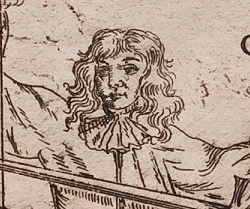 | |
| Born | 17th century |
| Died | after 1679 |
| Occupation | Fencing master |
| Movement | Freifechter |
| Influences | |
| Genres | Fencing manual |
| Language | New High German |
| Notable work(s) | Der Kůnstliche Fechter (1679) |
Theodori Verolini (Theodorus Verolinus) was a 17th century German Freifechter. Little is known about this master's life, but in 1679, he published a fencing manual entitled Der Kůnstliche Fechter ("The Artful Fencer"), a brief overview of the teachings of Joachim Meÿer, possibly via Jakob Sutor von Baden, in addition to the complete grappling teachings of Nicolaes Petter (uncredited in both cases).
Contents
Treatise
The fourth book, on grappling, is laid out on the Nicolaes Petter page.
Illustrations |
Transcription | |
|---|---|---|
|
The Artful Fencer Or the well-practiced and famous Fencing Master of Old THEODORI VEROLINI. Short though clear description and demonstration of the Free Knightly and Noble Art of Fencing With rappier, dussack and sword From which then along with the attached Art of Grappling Can be learned how in all kinds of occurring situations, with various usual weapons,
the favourable student can be trained to agility, and can encounter his opponent
dexterously. Illustrated in more than 130 displayed Figures and divided into four parts. First part. Würtzburg, by Joann Bencard, Bookseller, 1679. |
[Ttl] Der Kunstilche Fechter: Oder Deß Weyland wohl=geübten und berühmten Fecht=Meisters THEODORI VEROLINI. Kurtze / jedoch klare Beschreibung und Außweisung Der Freyen Ritterlichen und Adelichen Kunst des Fechtens Im Rappier / Dusacken und Schwerd / Wie dann auch mit angehángter Ring=Kunst: Daraus zu lernen / wie sich bey allerhand vorfallenden Gelegenheiten / in allerley gebräuchlichen Wehren / die angenehme Schuler / zur Behendigkeit künstlich mögen abgericht / und ihrem Gegentheil geschicklich begegnen möge. In mehr als CXXX. Abgebildeten Figuren vorge=stellet / und in vier Theil abgetheilt. Ersten Theil: Würtzburg / bey Joann Bencard Buchhändlern / Ⅿ ⅮⅭ ⅬⅩⅩⅨ. | |
Content and clear account of the first part of fencing with the sword and an ordering of the same. I name the beginning the onset, when you set upon the man that you have in front of you. The middle, the working-amongst, or handiwork, when you remain in the bind or longer in your work against the opponent, and harass him with all swiftness. The end, the withdrawal, how a fighter can cut off and away from his opponent without harm. |
[1.1] Inhalt und klarer Bericht deß ersten Theils Vom Fechten deß Schwerdts, und Ordnung desselben. DEn Anfang nen̄e ich das Zufechten, wann einer gegen dem Man̄, den er vor sich hat, zusicht. Das Mittel die Beyarbeit oder Handarbeit, wan̄ einer im Bund oder lenger in seiner Arbeit wider den Gegenfechter verharret, und ihm mit aller Geschwindigkeit zusetzet. Das Ende den Abzug, wie sich der Fechter von seinem Gegenpart ohne Schaden ab= und weghauen möge. | |
The onset in the beginning happens out of or from the guards with the cuts, which are twofold, namely the main guards and the secondary guards, that arise from the main guards. |
[1.2] Das Zufechten im Anfang geschicht aus, oder von den Legern mit den Häuwen, welcher zweyerley seynd, nemlich die Hauptleger von den Beyleger, so aus dem hauptleger entspringen. | |
There are four main guards, the Tag or Upper-ward, the Ochs, the Olber, and the Pflug. There are eight secondary guards: Wrath-ward, Break-window, Long-point, Barrier-ward, Unicorn, Key, Iron-gate, Change. But as far as the sword is concerned the cuts are in two sorts, which two are generally named the straight and reverse cuts. The first are called the main or principal cuts, from which all other cuts have their origin, and of these there are four: Upper-, Under-, Middle- and Wrath-cut. The others are called the secondary, or derived cuts, and there are twelve of them, namely Squint-, Crooked-, Shorten-, Glinting-, Bruising-; single and double, Blinding-, Winding-, Crown-, Knuckle-, Plunge-, and Change-cut. From these two are taken the true Master-cuts, which are named so because all masterly and artful devices with the sword are grasped and completed in these, namely Wrath-, Crooked-, Athwart-, Squint-, and Crest-cut. And of all these I will clearly bring to the light how to complete and perform them in their description, when I come to the onset, and speak of the cuts. |
[1.3] Der Hauptleger seynd viere, der Tag oder Oberhüt, der Ochs, der Olber, und der Pflug. Der Beyleger achte, Zornhüt, Brechfenster, Langort, Schanckhüt, Einhorn, Schlüssel, Eysenport, Wechsel. Der Häuw aber so viel das Schwerdt belangt, sein zweyerley Art, welche beyde in gemein die Gerade und verkehrte Häuw genennt werden. Die erste heissen die Haupt= oder Principal=Häuw, aus welchen alle andere Häuw ihren Ursprung haben, und deren seynd vier, Ober= Under= Mittel= Zornhauw. Die andern werden die bey= oder daraus wachsende Häuw geheissen, deren zwölff seynd, nemlich, Schiel, Krum, Kurtz, Glitz, Brell, Einfach und Dopel, Blend, Wint, Kron, Knichel, Sturtz, Wechselhauw, &c. Auß diesen beyden werden genommen die rechte Meister=Häuw, welche darumb also genennt werden, das alle meisterliche und künstliche Stuck im schwerdt, in solchen begriffen und vollbracht werden, nemlich Zorn, Krum, Zwerch, Schieler, Scheitelhauw, welche alle wie sie vollbracht un̄ gemacht werden sollen, will ich in ihrer Beschreibung, so ich auf das Zufechten komm, und von den Häuwen sag, klärlichen an Tag thun. | |
The handiwork in the middle contains the greatest art, and all swiftness that can occur in fencing. Since this does not only indicate, how you shall bind the sword, wind, change, deceive, travel after, slice, double, let it run off, or in which manner you shall strike around, sling, slide in front, set aside, pull and jerk, block, grapple, run in, throw and press after |
[1.4] Die bey der Hand=Arbeit im Mittel begreifft die gröste Kunst, und alle Geschwindigkeit die im Fechten kan fürlauffen. Denn ste zeigt nicht allein an, wie man das Schwerdt anbinden, Winden, Wechseln, Verführen, Nachreisen, Schneiden, Doplieren, Ablauffen soll lassen, oder welcher gestalt man umschlagen, Schlaudern, Vorschieben, Absetzen, Zuchen und Rucken, Verstellen, Ringē, Einlauffen, Werffen und nachtringē soll. | |
Of the man and his division. The man is divided into four parts, namely the above and under, and each of these in right and left. How the appearance of someone indicates what parts of him are above and below, and left and right, is explained by the image in Figure A. |
[1.5] Von dem Manne und desselbigen Theilunge. Der Mann wird abgetheilet in vier Theil, in das Ober und Under, und der jedes in das Recht und Linck, wie der Augenschein solches gibt am Menschen, was an ihme das Oberste und Underste, auch Recht und lincke Theil sey, erklärt das Bild in der Figur A. | |
Of the sword and its division. The blade has two divisions. The first is into the strong and weak. The second into the short and long edge, i.e. front and back. |
[1.6] Von dem Schwerdt und seiner Außtheilung. Die kling hat zwo Theilungen, der erste ist in der Stärcke und Schwäche, die ander in die kurtze und lange Schneide, das ist forder und hinder. | |
The part from the cross or hilt to the middle of the blade is named the strong of the sword. The weak is from the middle to the end of the same. |
[1.7] Die Stärck des Schwerdts nennet man den Theil vom Kreutz oder Hefft, biß mitten in die Klinge, die Schwäche von der Mitten biß an das End derselben. | |
In general the sword has four parts as can be seen in Figure A. |
[1.8] Das Schwerdt in gemein hat vier Theil wie in der Figur A zusehen. | |
The first is named the hilt, and contains the pommel and cross. Expedient for grappling, gripping, and throwing. |
[1.9] Der erste wird genandt, das hefft begreifft in sich Knopff und Kreutz, zum zum[!] Einlauffen, Ringen, Greiffen, Werffen dienlich. | |
The second, the strong, is useful for slicing, winding, pushing and what is fenced from the strong. |
[2.1] Der ander die Stärck zum Schneidenn, Winden, Trucken, und aus der Stärck gefochten nützlich. | |
The third part is the middle, which is used on every occasion. |
[2.2] Der dritte Theil ist das Mittel, wird nach eines jeden Gelegenheit gebraucht. | |
The fourth is the weak, for changing through, flicking, slinging, for which you will have examples, then. |
[2.3] Der vierdte ist die Schwäche zum durchwechseln, Schnellen, Schlaudern, wie du denn Exempel haben wirst. | |
Of the guards or wards. The wards and guards are graceful, in which the fencer positions and sets himself in the place before his opponent comes to him, so that he is not rushed unforeseen, and injured by him, setting himself against the counterpart. As a man is divided into four quarters, high, low, left, and right, there are likewise four openings in which to hit the opponent mainly. And as there are four openings, there are likewise four main guards or wards, from which all the others derive and arise, as there are Ochs, Pflug, Tag and Olber. But the others, that have originated from these, are Wrath-ward, Long-point, Change, Side-ward, Iron-gate, Hanging-point, Key, Unicorn, which then will be treated orderly and briefly. |
[2.4] Von den Legern oder Hüten. Die Hüt oder Leger seynd zierlich, in welche sich der Fechter, ehe sein Gegenpart zu ihm kompt auf den Platz, stellet und legert, damit er nicht unversehens von ihm übereilet und verletzt, gegen seinem Widerpart legern, wie der Mann in vier Quatier, Ober= Under= Recht = und Linck getheilt, so seynd der Blössen auch vier, darauff der Gegenfechter fürnemlich zu treffen, und wie vier Blösse, also seynd auch gleichfals viererley Hauptleger oder Hüten, daraus die andern alle herkomen und entspringen, als der Ochs, Pflug, Tag, und Olber, die andern aber so hieraus entstehn, seynd Zornhüt, Langort, Wechsel, Nebenhüt, Eysenport, Hengetort, Schlüssel, Einhorn, davon denn ordenlich und kürtzlich soll gehandelt werden. | |
Ochs. The upper part of a man is assigned to the Ochs, and as that part has two quarters, the right and the left, the guard of Ochs can also be divided into two, as is demonstrated in Figure B. |
[2.5] Ochs. Der Obertheil am Mann wird dem Ochsen zugetheilt, und wie dasselbige zwey Quatier hat, das Rechte und Lincke, also kan man auch das Leger des Ochsens in zwey Theil, so in der Figur B verzeichnet ist. | |
Pflug. The lower part of a man is dedicated to the Pflug, and like that part has two quarters, the right and the left, hence the Pflug is also called the right and the left, or the point in the man’s face is also the right Pflug in the conceived Figure B. |
[2.6] Pflug. Der Undertheil des Man̄s wird dem Pflug zugeeygnet, und gleicher Gestalt wie dieselbige zwey Quatier die Rechte und Lincke hat, also wird auch daher der Pflug der Rechte und der Lincke geheissen, oder den Orth dem Mann ins Gesicht, ist also der recht Pflug in gedachter Figur B. | |
Tag. Stand with your left foot in front, hold your sword high over your head, as in the Figure B.[1] |
[2.7] Tag. Stehe mit deinem lincken Fuß vor, halt dein Schwerdt hoch über deinem Haupt, wie der Figur B. | |
Olber. Stand with the left foot in front, hold your sword with the point stretched out in front of you to the ground, in front of your front foot, so that the short edge is above, the long below. Thus you stand well in this ward, as you can see in Figure C. |
[2.8] Olber. Stehe mit dem lincken Fuß vor, halt dein Schwerdt mit dem Ort vor dir außgestreckt aus die Erden, für deinen vorgesetzen Fuß, daß die kurtze Schneid oben, die Lange unden stehe, so ligst du in dieser Hüt recht, wie du in der Figur C sehen kanst. | |
Wrath-ward. Stand with your left foot in front, hold your sword on the right shoulder, see Figure E. |
[2.9] Zornhüt. Stehe mit deinem lincken Fuß vor, halt dein Schwerdt auf der rechten Achsel, besihe die Figur E. | |
Long-point. Stand with your left foot in front, hold your weapon with outstretched arms, long in front of your face, as Figure A teaches you. |
[2.10] Langort. Steh mit deinem lincken Fuß vor, halt dein Wehr mit ausgestreckten Armen, lang für deinem Angesicht, wie dich die Figur A lehret. | |
Change. Stand with your right foot in front, hold your weapon with the weak to the ground next to you stretched out to the side, as in Figure D. |
[2.11] Wechsel. Stehe mit deinem rechten Fuß vor, halt deine Wehr mit Schwäch auff der Erden neben dir zur Seiten außgestreckt, wie in der Figur D. | |
Side-ward. Stand with the left foot in front, hold your sword next to your right, with the point to the ground, as in Figure [F].[2] |
[2.12] Nebenhüt. Stehe mit dem lincken Fuß vor, halt dein Schwerdt neben Rechten, mit der Spitzen auff der Erden, wie Fig. | |
Iron-gate. Stand with your right foot in front, hold your sword with the hilt in front of your knee, with strong[3] hanging arms, as can be seen in Figure F.[4] |
[2.13] Eysenport. Stehe mit deinem rechten Fuß vor, halt dein Schwerdt mit dem Hefft vor deinem Knie, mit starcken hangenden Armen, wie in der Figur F zuersehen. | |
Hanging-point. This guard is almost completely of the same shape as the Ochs, except that in the Ochs you hold the arm strongly[3] up high, as in Figure B. |
[2.14] Hangetort. Diß Leger ist durchaus fast dem Ochsen gleich förwig, allein das du ihm Ochsen die Arm starck in die Höhe empor haltest, wie in der Figur B. | |
Key. Stand with your left foot in front, and hold your sword with the hilt and crossed hands in front of your breast, as in Figure D. |
[2.15] Schlüssel. Stehe mit deinem lincken Fuß vor, und halt dein Schwerdt mit dem Hefft und gecreutzigten Händen vor deiner Brust, wie in der Figur D. | |
Unicorn. Come into the onset with the left foot in front. Wing up from both sides, as if you want to set yourself in the aforementioned Key, as in Figure E. |
[2.16] Einhorn. Komm im Zufechten mit dem lincken Fuß vor, Flügel von beyden Seiten auf, als wollestu dich in vorgenanten Schlüssel Lägern, wie in der Figur E. | |
Of the guards. Firstly, when you do the Upper- or Crest-cut, you will find three guards, as in the beginning you are in Tag, in the middle in Long-point, at the end in Olber, thus from the top down you have three wards or guards from A. and E. When you go up again from below with crossed hands to the displacement, you again find three guards. Namely at the beginning Iron-gate, in the middle the Hangort, at the end upwards at full height the Unicorn. If you pull your sword with the hilt in front of the breast, so that the half edge lies on your left arm, then you stand in Key. Thus you can go up and down in the line A. and E. from one guard into the other. |
[2.17] Von den Legern. Erstlich so du den Obern oder Scheitelhauw thust, findestu drey Leger, dann im Anfang ligstu im Tag, im Mittel im Langenort, am End im Olber, also hastu in der geraden Lini von oben herab von A. und E. drey Hüten oder Leger, fehrestu wiederumb von unden herauff mit ge= [3.1] schrenckten Händen zur Versatzung, befindestu abermals drey Leger, Nemlich im Anfang Eysenport, im Mittel das Hangort, im End übersich in voller Höh das Einhorn, ziehest du dein Schwerdt mit dem Hefft vor die Brust, daß die halbe Schneid auff deinem lincken Arm ligt, so stehestu im Schlüssel, also kommestu ihm auf= und abfahrren in der Lini A. und E. aus einem Leger in das Ander. | |
Of the other Lines, which strike diagonally downwards through the right Line, there are two. One that strikes from the right upper quarter, indicated with H. and D., and the other which goes from the left upper part to the right lower part, demonstrated in B.F. You can now cut through which you want. If you then pull the strike up again with the long edge, then you again go through three guards, as at the beginning there is the Side-ward, in the middle again the Long-point, and in the end upwards the Unicorn. If you strike one through the above-mentioned Line, it can be from which side you want, then you come from the Change, through the Long-point, into the Wrath-ward. In striking up, you can also turn your sword in the Hanging-point, from which you come into the ward of Ochs when you go further upwards. Thus you always find at least three guards whenever you go through one of the demonstrated Lines. |
[3.2] Der andern Linien so schlim durch die rechte Lini herabwarts streichen, seynd zwo, eine die von dem rechten Oberquatier streichet, mit H. und D. bedeutet, die Andere die von dem lincken Obertheil zu dem rechten Untertheil geht, im B.F. gezeichnet, du hauwest nun durch welche du wilst. Ziestu von dannen den Streich wider herauff mit langer Schneid, so so[!] gehestu wider durch drey Leger, als im Anfang gibt es die Nebenhüt, in der Mit widerumb das Langort, und im Endt übersich das Einhorn, Streichestu durch obermelten Lini eine, sey von welcher Seiten es wölle, so kom̄estu auß dem Wechsel durch das Langort in die Zornhüt, auch kanstu im Auffstreichē dein Schwerdt verwenden in das Hangentort, aus welchem so du ferner übersich fahrest kommestu in die Hüt des Ochsens, also findestu alleweg so offt du dergezeichneten Lini eine durchfährest, auff das wenigste drey Leger. | |
But a good fencer will not habituate to wait long in his guard, but as soon as he can reach an opponent, he will attack him, and fence out his intended device. |
[3.3] Es soll sich aber ein guter Fechter nicht gewehnen, in seinem Legern lang zuwarten, sondern alsbald er einem gegen Man̄ kan erlangen, denselben angreiffen, und sein vorgenommen Stuck außfechten. | |
Middle- or Across-cut.[5] The Middle- or Across-cut can almost completely be performed as the Wrath-cut, only this is the difference that the Wrath-cut is performed diagonally over the point, but this one across, as recorded in the Figures C. and G.[6] |
[3.4] Mittel= oder Uberzwerchhauw. Der Mittel= oder Uberzwerchhauw, kanst fast allerding wie der Zornhauw gemacht werden, allein ist diß der Underschied, daß wie der Zornhauw schlims über Ort, also dieser aber überzwerch vollbracht wird, wie in den Figuren C und G verzeichnet. | |
Undercut. Cut across from below, to his left arm, so that with your cross you come high above your head, as in Figure B. |
[3.5] Underhauw. Hauw von Unden überzwerch, nach seinem lincken Arm, daß du mit dem Kreutz hoch über deinem Haupt kom̄est, wie in der Figur B. | |
Squint-cut. Set yourself in the ward of the Tag or the Wrath-ward with the left foot in front. If someone cuts at you, then cut against it, but in the strike turn your short edge against his strike, as in Figure G. |
[3.6] Schielhauw. Stell dich in die Hüt des Tags oder Zorns mit dem lincken Fuß vor, wird auff dich gehauen, so haue hingen, doch im Strich verwende dein kurtze Schneid gegn seinem Streich, wie in der Fig. G. | |
Crooked-cut. Stand in the Wrath-ward with the left foot in front. If your opponent cuts at you, then step with your right foot in front, cut with the long edge against his cut, between his head and his blade, as in Figure D. |
[3.7] Krumphauw. Stehe in der Zornhüt mit dem lincken Fuß vor, hauet dein gegen Man̄ auf dich, so tritt mit deinem rechten Fuß vor, haue mit langer Schneid seinem Hauw entgegen, zwischen seinen Kopff und Klingen, wie in der Figur D. | |
Athwart-cut. Place yourself in the Wrath-ward on the right side. Set your left foot in front, hold your sword on your right shoulder, as in Figure H.[7] |
[3.8] Zwerch. Stell dich in die Zornhüt zur Rechten, setz deinen lincken Fuß vor, halt dein Schwerdt an deine rechte Achsel, wie in der Figur H. | |
Shorten-cut. Strike with the half edge and crossed arms over his right arm to the head, as in Figure B. |
[3.9] Kurtzhauw. Schlage mit halber Schneid und geschrenckten Armen über seinen rechten Arm zum Kopff, wie in der Figur B. | |
Bruising-cut. When your counterpart cuts at you from above, then meet his strike with an Athwart-cut, as recorded in Figure K and I. |
[3.10] Prellhauw. Hauwet dein Gegentheil auf dich von Oben her, so begegne seinem Streich mit einer Zwerch, wie in der Figur K und I verzeichnet. | |
Winding-cut. If your counterpart cuts at you from above, then cut from below with crossed hands, from your left to his sword, as in Figure H.[8] |
[3.11] Windhauw. Hauet dein Gegenpart auff dich von Oben, so hauwe von Unden mit gekreutzten Händen, von deiner lincken an sein Schwerdt, wie in der Figur H. | |
Crown-cut. When your counterpart cuts at you from above, then go upwards with the cross across, catch him his strike in the air on your shield or crossbar. |
[3.12] Kronhauw. Wann dein Widerpart von Oben auf dich hauwet, so fahre mit überzwerchen Kreutz übersich, fang ihme seinē Streich in der Lufft auff dein Schilt oder Kreutz= Stang. | |
Knuckle-cut, Plunge-cut, Change-cut. The Change-cut is nothing else than always alternating the cuts before the man from one side to the other, from above to below, and back again, to make him err. |
[3.13] Kniechelhauw, Sturtzhauw, Wechselhauw. Der Wechselhauw ist nichts anders, dann vor Manne mit den Häuwen von einer Seiten zu andern, von Oben zum Undern, und hinwider immer abwechseln, ihn damit irze zumachen. | |
Shooting or Provoke-touching. Shooting or Provoke-touching are almost one thing, which actually are not cuts that are cut but flicked. |
[3.14] Schneller oder Zeckrür. Schneller oder Zeckrür ist fast ein Ding, welche eigentlich nicht Häuw seynd die gehauwen, sondern geschnelt werden. | |
Handiwork. The full handiwork consists mainly of binding or staying, traveling after, slicing, striking around, running around, deceiving, flitting, setting aside, displacing, pulling, doubling, reversing, snapping, feinting, looping circles, winding, winding through, changing, Changing through, slicing off, pressing hands, sliding in front, hanging, wrenching out, barring, blocking, gripping over, running in, etc. |
[4.1] Hand=Arbeit. Die gantze Hand=Arbeit bestehet vornemlich im Binden oder Bleiben, Nachreisen, Schneiden, Umbschlagen, Umblauffen, Verführen, Verflügen, Absetzen, Versetzen, Zucken, Dopolieren, Verkehren, Schnappen, Felen, Zirckeln Rinden, Windē, Durchwinden, Wechseln, Durchwechseln, Abschneiden, Händrucken, Vorschieben, Hengen, Außreissen, Sperzen, Verstellen, Ubergreiffen, Einlauffen, &c. | |
Binding, staying, feeling. Is when the swords touch one another. Staying is twofold, when the swords held to each other, to see how the man wants to fight etc. |
[4.2] Anbinden, Bleiben, Fülen. Heist wann die Schwerdter an einander rühren, Bleiben ist zweyerley, wan̄ die Schwerdter an einander gehalten, zusehen was der Man̄ will fechten &c. | |
Slicing. After you have received your opponent's sword with the bind, you will remain on there, to feel if he wants to go from the bind, or strike around. Let it fly, and before he can recover, you cut to the nearest opening. |
[4.3] Schneiden. Nach dem dn deines Widerparts Schwerdt mit dem Band empfangen, soltu daran verharzen, zufülen ob er vom Band abgehn, oder umbschlagen wolt, laß fliegen, und ehe er sich erholen mag, so hauwe der nechsten Blössen zu. | |
Striking around. When you are bound from your right against his left, and you go away again that bind, to strike around or flick to to the other side. |
[4.4] Umbschlagen. Wann du von deiner Rechten gegen seiner Lincken angebunden, vom selben Band wider abgehest, zur andern Seiten umbschlägest oder zuschnellest. | |
Deceiving. When you show yourself with gestures as if you want to onset an opening on your counterpart, but you do not do it, and strike the strike in to another opening. |
[4.5] Verführen. So du dich mit Gebärden erzeigest, als ob du deiner Gegenpart zu einer Blöß zufechten wöllest, thust es aber doch nit, sondern schlägst den Streich zu einer andern Blöß hinein. | |
If your counterpart cuts at you from above, then step and from your right side, with a Middle-cut across, cutting his strike away from you with the long edge as it flies in, then through so that your blade flies around again, with the half edge against his left ear, as can be seen in Figure A. |
[4.6] Hauwet dein Gegentheil von Oben auff dich, so trtit und hauw ihm von deiner Rechten, mit einem überzwerchen Mittelhau, seinen herfliegenden Streich mit langer Schneid von dir weck, auch durch, daß dir dein Klinge wieder umbfliege, mit halber Schneide gegen seinem lincken Ohr, wie in der Fig. A. zu sehen. | |
In the taking-out course, let your blade, in one flight, fly with an Athwart-cut above around your head, against his left ear. Then pull your sword around your head again, and with the outside flat cut a strongly swung in strike on the outside to his right ear, as you see this flat strike painted in the large image on the right hand side in Figure K. |
[4.7] Laß dein Klingen in außnemmenden Lauff, in einem Flug mit einer Zwirch oben umb deinen Kopff, gegen seinem lincken Ohr fliegen, von dannen zuck dein Schwerdt wieder umb dein Kopff, und hauwe mit außwendiger Fleche, einen starcken eingeschwungenē Streich, außwendig zu seinem rechten Ohr, wie du solchen Flechstreich an dem grössern Bild zur rechten Hand, in der Figur K fürgemahlt sihest. | |
Hanging-point. In the onset strike through powerfully from your left side upwards against his face, in one wheel once, twice, and the third time, however, always let your sword swing in front of your face, or turn into the Hanging-point, as the image on the right hand side in Figure F here presented teaches you. |
[4.8] Hanget ort. Im Zufechten so streich gewaltiglich von deiner Lincken übersich gegen seinem Gesicht durch, in einem Raht einmal zwey, und das dritte mal aber laß allwegen dein Schwerdt vor deinem Gesicht verschwingen, oder verwende in das Hanget ort, wie dich das Bild zur rechten Hand in der Figur mit dem F. hie zu gegen lehrt. | |
Break-window. If someone cuts from above, then cut against this from your left from below with the long edge, and when he takes his sword off yours again, and thus drives with his arms upwards, then in the meantime grip with your fingers over your cross on the blade, and drive with your blade over both his arms, as you see this on Figure M. |
[4.9] Brechfenster. Hauwet einer von oben, so haue demselbigen von deiner Lincken von unden entgegen mit langer Schneide, und in dem er sein Schwerdt wieder von dem deinen abnimbt, und also mit seinen Armen übersich fährt, so greifft der weil mit deinen Fingern über dein Kreutz in die Klingen, und fahr ihm mit deinem Klingen über beyde Arm, wie du solches an der Figur M. sihest. | |
Step in haste, and cut in from below to his left side, so that your hands stay high. With this you force him to either displace you from his guard, or to cut in at the same time with a step back. If he then cuts, then note the moment the swords beat together, and pull around the head, and cut in to his right ear in one swing with crossed hands, with the short edge, as this Figure G. shows. |
[4.10] Tritt in eyl, und hau von unden zu seiner Lincken ein, daß deine Händ hoch bleiben, damit zwingest du ihn, daß er dir entweder aus seinem Leger ersetzen, oder mit einem Abtritt zugleich einhauen muß, hauet er denn, so merck alsbald die Schwerdter zusammen rühren, so zuck umb den Kopff, und hauw in einem Schwung mit geschrenckten Händen die kurtz Schneid zu seinem rechten Ohr ein, wie diese Figur G. außweiset. | |
A fine device from the reversing. In the onset note and watch out for when your opponent rises before you. Then step and cut from your left side with the short edge and crossed hands to or over the right arm, but in this Crooked-cut step well to him, reverse your sword and wrench out downwards, on your right side. If he works upwards with his arms so that you can force him downwards, then drive with the pommel from inside between both his arms, loosen your left hand from the hilt, and with that grip your sword’s blade, and wrench out upwards, as Figure O. demonstrates. |
[4.11] Ein fein Stuck aus dem Verkehren. Merck im Zufechten hab acht, wenn dein Widerpart für dir aufgehet, so tritt und hauw von deiner Lincken mit kurtzer Schneid un̄ geschrenckten Händen zu oder über den rechten Arm, aber in diesem Kruwphauw tritt wohl zu ihm, verkehr dein Schwerdt, und reiß undersich aus, auf dein rechte Seiten, arbeitet er übersich mit den Armen also, daß du ihn undersich zwingen magst, so fahr mit dem Knopff von inwendig zwischen sein beyde Arm, laß dein lincke Hand vom Hefft, greiff damit dein Schwerdts Klingen, und reiß übersich aus, wie die Figur O. angeiget. | |
Counter for the Athwart-cut. When you bind with someone from above, or cut in at the same time with him, then see whether he wants to strike around with the Athwart-cut. While he strikes around, preempt with the Athwart-cut below his blade to his neck, as Figure L. demonstrates. |
[4.12] Bruch auff die Zwirch. Wann du mit einem von oben bindest, oder gleich mit einem einhauest, so sihe ob er mit der Zwirch wöll umbschlagen, in dem er umbschlägt, so kome vor mit der Zwirch under seiner Klingen an sein Halß, wie in der Figur L. anzeiget. | |
Item, if he cuts-Athwart from below, so that you cannot come under it, then catch his Athwart-cut on your shield with a sliding in front, and thrust your pommel well from you above your right arm, and turn him the long edge over his blade on the outside up from below to the head, as can be seen in Figure N. |
[4.13] Item, zwircht er von unden, daß du darunter nicht kommen kanst, so fange sein Zwirch mit fürschieben an dein Schilt, und stoß dein Knopff oberhalb deinem rechten Arm wohl von dir, und wend ihm die lange Schneid aussen über seiner Kling von unden auf zum Kopff, wie in der Figur N. zu sehen. | |
A breaking for all Upper-cuts. While you wind out the Under-cut through an Upper-cut against his face, in the same moment, step with the left foot further out to the left side back behind yourself. Then in stepping back, cut him through his face. Now, when this Under-cut with the stepping out, and winding out is performed and completed skillfully in one go, then it will go safely and well for you. From this Winding-cut many other and beautiful devices are taken and pulled off. |
[4.14] Ein Bruch auf alle Oberhäuw. In dem du den Underhau durch einen Oberhauw gegen seinem Gesicht herauß windest, eben dieselbige Weil, tritt auch mit dem lincken Fuß ferner gegen der lincken Seithen aus zurück hindersich, haue ihn also im Abtretten durch sein Gesicht, wann nun dieser Unterhauw sampt dem Außtritt, und heraus winden in einem huy behendiglichen gemacht und vollbracht wird, so geht es dir gewiß und wolan, aus diesem Windhauw werden auch viel andere und schöne Stuck genommen und zu wegen bracht. | |
End of the sword. |
[4.15] Ende deß Schwerdts. |
Illustrations |
Transcription | |
|---|---|---|
| Translation | Transcription |
Illustrations |
Transcription | |
|---|---|---|
| Translation | Transcription |
For further information, including transcription and translation notes, see the discussion page.
| Work | Author(s) | Source | License |
|---|---|---|---|
| Illustrations | Herzog August Bibliothek Vol 1-3 · Vol 4 | ||
| Translation | Reinier van Noort | Ense et Mente | |
| Transcription | András Berki | Index:Der Kůnstliche Fechter vol. 1 (Theodori Verolini) 1679.pdf Index:Der Kůnstliche Fechter vol. 2 (Theodori Verolini) 1679.pdf Index:Der Kůnstliche Fechter vol. 3 (Theodori Verolini) 1679.pdf Index:Der Kůnstliche Fechter vol. 4 (Theodori Verolini) 1679.pdf |
Additional Translation Notes: Copyright 2015 by Reinier van Noort. Subject to Fair Use. Users may, without further permission, display, save, and print this work for personal, noncommercial use, provided that the copyright notice is not severed from the work. Libraries may store this material and non-commercially redistribute it to their patrons in electronic or printed form for personal, non-commercial use, provided that the copyright notice is not severed from the work.
Additional Transcription Notes: The following document is a digital version of the transcription or translation of an existing historical document or manuscript. It is provided in a Portable Document Format (PDF) for the purpose of making it freely available to the public. Feel free to redistribute unaltered copies of this document via electronic means. You may not, however, alter the document without permission nor profit from its redistribution. For further information visit the following link: http://hemac.org
Additional Resources
The following is a list of publications containing scans, transcriptions, and translations relevant to this article, as well as published peer-reviewed research.
- None.
References
- ↑ This is a typo and should be Figure C.
- ↑ This should be Figure F. Note that the fencer standing in Side-ward in this figure grips the ricasso with his right hand.
- ↑ 3.0 3.1 It is not unlikely that instead of starck (“strong”), strack (“straight”) was meant here.
- ↑ Iron-gate is not shown here (see also Meyer, 1570).
- ↑ Überzwerch is somewhat tricky to translate. It literally means “across” and thus indicates a movement or position crossing the centre line between the fighters. However, in some cases it could also be translated as “horizontal”. Here, we have chosen to consistenly translate as “across”.
- ↑ This is an error, and intended to refer to the G-C line on the cutting diagram.
- ↑ This is a typo and should be Figure E.
- ↑ Maybe also E.

